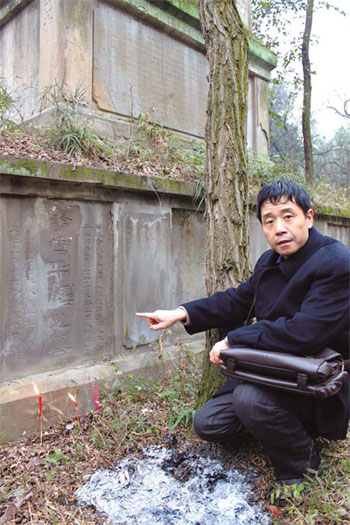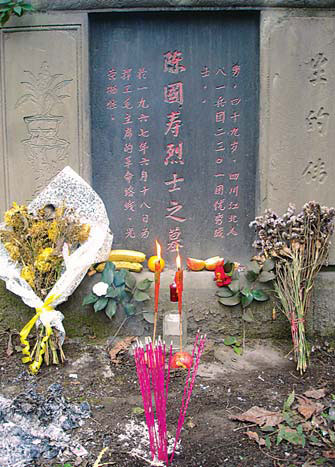Society
Red Guards cemetery reveals scars yet to heal
By Peng Yining (China Daily)
Updated: 2010-04-08 06:47
 |
Large Medium Small |
Lessons of the past
|
 Retired Chongqing teacher Zeng Zhong, 58, has spent the past five years studying the "red guard" cemetery and its gravestones. [China Daily] |
Administrators of Shapingba Park decided to put the cemetery forward for city-level heritage status following a 2008 speech by Shan Jixiang, director of the State Administration of Culture Heritage, in which he said "all typical constructions and buildings should be protected".
Almost a year passed before the application was approved by Chongqing's bureau of culture relics.
Although the restoration plan promised by the city government is yet to be finalized, "at least it guarantees its protection", said Zeng, who recalled a local official in 1985 who said the site should be destroyed as it represents "an ignominious history".
Officials for Shapingba Park, the cemetery and city authority declined to comment, only to say there are no plans to open the cemetery to the public. An on-site gatekeeper only opens the gates for relatives of those buried in the cemetery.
"As time goes on, people will become more comfortable talking about wu dou and the 'cultural revolution'," said Chen Xiaowen, 54, editor of Chongqing Publishing House, who has been collecting research on the "red guard" graveyard for more than 20 years. "Recognizing the cemetery as culture heritage is just the first step in learning the lessons of the past."
In 2007 and 2008 Chen met teachers leading student field trips to the cemetery, one from a nearby junior school and the other from a local college.
"These teachers were both younger than 30," he said. "They didn't live through that era but they still showed huge interest in their nation's past, and wanted to pass that on to their students.
The more relics from the 'cultural revolution' that are protected, the more opportunities people have to learn the history."
In the 1980s, Chen had to scale the wall of the cemetery to record the inscriptions on the tombstones.
"They read, 'Dear comrade in arms', 'Go forward in the revolution', 'Where there is struggle, there is sacrifice', Turn the sadness into strength'. Since then, about 80 percent of the inscriptions have eroded away," he said.
He Shu, 62, a "cultural revolution" researcher based in Chongqing, said recognizing the heritage of the cemetery not only comforts those who survived, but will also help prevent a repeat of the violence.
"Some people are afraid the past will threaten the harmony. In fact, facing the past and comforting the victims is the best way to maintain social stability," he said.
However, the decision to give the cemetery cultural heritage status was probably just a "good luck", added He.
"The success of the Shapingba Park cemetery application has brought hope to people behind the museum idea," said retired researcher He.
This week marked qingming jie, or Tomb-sweeping Day, when relatives traditionally visit their loved ones' tombs to burn money and incense, and one of the few days the silence is broken at the "red guard" cemetery.
"People who lived through the era will die and gravestones will decay," said a visitor by one grave who did not want to be identified. "People may be waiting for the history to disappear little by little, day by day. But it won't."
------------------------------------------------------------------------------------
|
 This picture taken in February shows a corner of the "cultural revolution cemetery" in Chongqing. [PENG YINING / CHINA DAILY] |
WHO WERE THE 'RED GUARDS'?
BEIJING — The "cultural revolution" officially lasted from 1966 to 1976 but the "red guards" were only active for the fi rst 30 months.
According to People's Daily, the "red guards" first appeared in Beijing in June 1966. On Aug 1, then-leader of the Communist Party of China, Mao Zedong, wrote to the "red guards" at the Middle School Affiliated with Tsinghua University.
In the letter he showed "passionate support" for the group, and after that the movement spread across the nation.
"Red guards" were largely high school and college students, and they traveled across the country to "connect" with each other. In 1966, Mao had eight official meetings in Beijing with a total of 13 million "red guards", the first on Aug 18 and the last on Nov 26.
The traveling and "connection" came to a halt only after Mao called for "revolution at the site" in August 1967. Mao issued a new command in December 1968 that said it was necessary for the "educated youth" to go to the countryside and to receive re-education from farmers.
The "red guards" movement was dissolved as students slowly moved into rural areas, according to Chen Yinan, a Beijing-based scholar on the "cultural revolution".
"Young students came to have a new name: 'educated youth', which replaced their old one of 'red guards'," said Chen. Many of educated youths did not return to urban areas until 1980, when the central government decreed they could return to their native cities.
WANG SHANSHAN – CHINA DAILY







